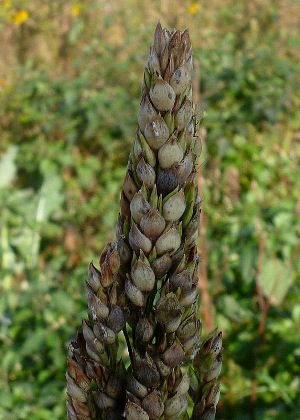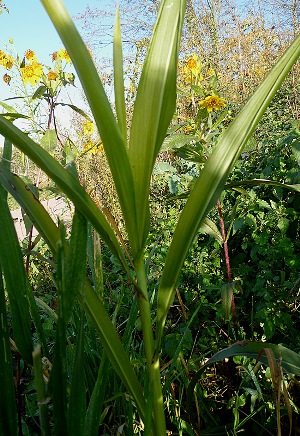Sorghum bicolor (L.) Moench (syn.: Andropogon sorghum (L.) Brot., incl.: S. caffrorum (Retz.) Beauv., S. cernuum (Ard.) Host., S. dochna (Forssk.) Snowden, S. saccharatum (L.) Pers., S. sorghum (L.) Druce, S. vulgare Pers.) (S-As.) – A common but ephemeral birdseed alien (introduced in commercial birdseed mixtures for cage birds), more rarely introduced for cattle fodder. Apparently first collected on rough ground in Tribomont in 1935. Often abundant along motor- and highways and near unloading quays in port-areas but never persisting. By far most records are from garbage dumps and other places where birdseed waste is discarded.
Sorghum bicolor is treated in a broad sense here. It is a very variable species with numerous cultivars. Mabberley (2008) distinguishes eight major cultivar groups that partly correspond with a previously recognized infraspecific division of the species. Some authors have recognized these taxa as distinct species (e.g. Tsvelev 1984) but this is not tenable. Several of these infraspecific taxa have been reported from Belgium in the past (Lambinon 1957) but their identification is usually very critical and often remains tentative. At present, in most modern floras, they are merely included in a broad species concept of Sorghum bicolor (e.g. Zuloaga & al. 2003).
One of the more remarkable variants, sometimes occurring in port-areas and on dumps, is a narrow-leaved form that somehow resembles Sorghum sudanense (Piper) Stapf. Such plants are possibly complex hybrids between Sorghum arundinaceum (Desv.) Stapf , the wild progenitor, and S. bicolor (S. xdrummondii (Nees ex Steud.) Millsp. et Chase; syn.: S. bicolor subsp. drummondii (Steud.) de Wet ex Davidse, see Wiersema & Dahlberg 2007). Another cultivated hybrid, Sorghum xalmum Parodi, probably is derived from S. bicolor (one of the cultivated races) and S. halepense (Parodi 1943).
Sorghum bicolor is increasingly cultivated in (southern) Europe. Cultivated plants are usually much taller (as in Stace 2010) but this does not hold true for the specimens found as aliens in Belgium.
The dimensions of the male spikelets given by Jansen (1951) are incorrect and apparently inversed.
 |
 |
 |
Selected literature:
Jansen P. (1951) Flora Neerlandica, deel 1, aflevering 2. KNBV, Amsterdam: 272 p.
Lambinon J. (1957) Contribution à l’étude de la flore adventice de la Belgique. I. Adventices rares ou nouvelles pour la Belgique. Bull. Soc. Roy. Bot. Belg. 89: 85-100.
Mabberley D.J. (2008) Mabberley’s plant-book (3th ed.). Cambridge University Press, Cambridge: XVIII + 1021 p.
Parodi L.R. (1943) Una nueva especie de “sorghum”, cultivada en la Argentina. Revista Argentina de Agronomia 10: 361-72.
Robbrecht E. (1983) Autosnelwegneofieten, een kategorie van graanadventieven in opkomst? Dumortiera 26: 6-13.
Tsvelev N.N. (1984) Grasses of the Soviet Union, part 1 and 2. A.A. Balkema, Rotterdam: XVI + 1196 p.
Wiersema J.H. & Dahlberg J. (2007) The nomenclature of Sorghum bicolor (L.) Moench (Gramineae). Taxon 56(3): 941-946. [available online at: http://naldc.nal.usda.gov/download/4229/PDF]

